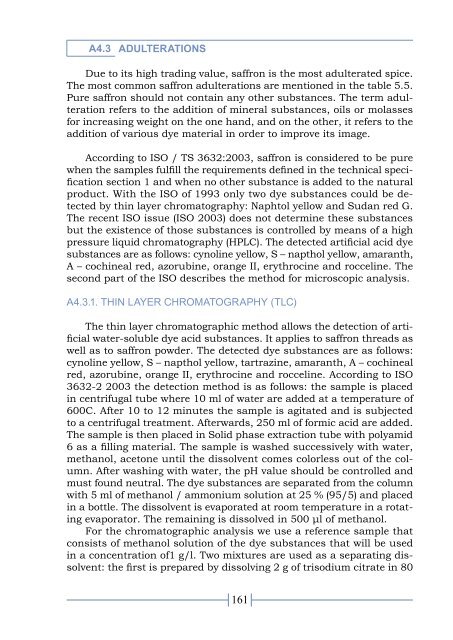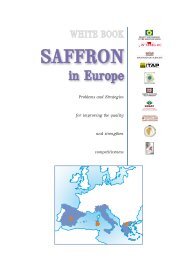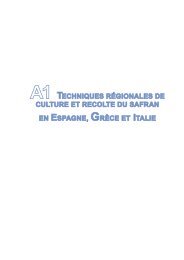Annex White book.pdf
Annex White book.pdf
Annex White book.pdf
You also want an ePaper? Increase the reach of your titles
YUMPU automatically turns print PDFs into web optimized ePapers that Google loves.
A4.3 ADULTERATIONSDue to its high trading value, saffron is the most adulterated spice.The most common saffron adulterations are mentioned in the table 5.5.Pure saffron should not contain any other substances. The term adulterationrefers to the addition of mineral substances, oils or molassesfor increasing weight on the one hand, and on the other, it refers to theaddition of various dye material in order to improve its image.According to ISO / TS 3632:2003, saffron is considered to be purewhen the samples fulfill the requirements defined in the technical specificationsection 1 and when no other substance is added to the naturalproduct. With the ISO of 1993 only two dye substances could be detectedby thin layer chromatography: Naphtol yellow and Sudan red G.The recent ISO issue (ISO 2003) does not determine these substancesbut the existence of those substances is controlled by means of a highpressure liquid chromatography (HPLC). The detected artificial acid dyesubstances are as follows: cynoline yellow, S – napthol yellow, amaranth,A – cochineal red, azorubine, orange II, erythrocine and rocceline. Thesecond part of the ISO describes the method for microscopic analysis.A4.3.1. Thin layer chromatography (TLC)The thin layer chromatographic method allows the detection of artificialwater-soluble dye acid substances. It applies to saffron threads aswell as to saffron powder. The detected dye substances are as follows:cynoline yellow, S – napthol yellow, tartrazine, amaranth, A – cochinealred, azorubine, orange II, erythrocine and rocceline. According to ISO3632-2 2003 the detection method is as follows: the sample is placedin centrifugal tube where 10 ml of water are added at a temperature of600C. After 10 to 12 minutes the sample is agitated and is subjectedto a centrifugal treatment. Afterwards, 250 ml of formic acid are added.The sample is then placed in Solid phase extraction tube with polyamid6 as a filling material. The sample is washed successively with water,methanol, acetone until the dissolvent comes colorless out of the column.After washing with water, the pH value should be controlled andmust found neutral. The dye substances are separated from the columnwith 5 ml of methanol / ammonium solution at 25 % (95/5) and placedin a bottle. The dissolvent is evaporated at room temperature in a rotatingevaporator. The remaining is dissolved in 500 μl of methanol.For the chromatographic analysis we use a reference sample thatconsists of methanol solution of the dye substances that will be usedin a concentration of1 g/l. Two mixtures are used as a separating dissolvent:the first is prepared by dissolving 2 g of trisodium citrate in 80161




